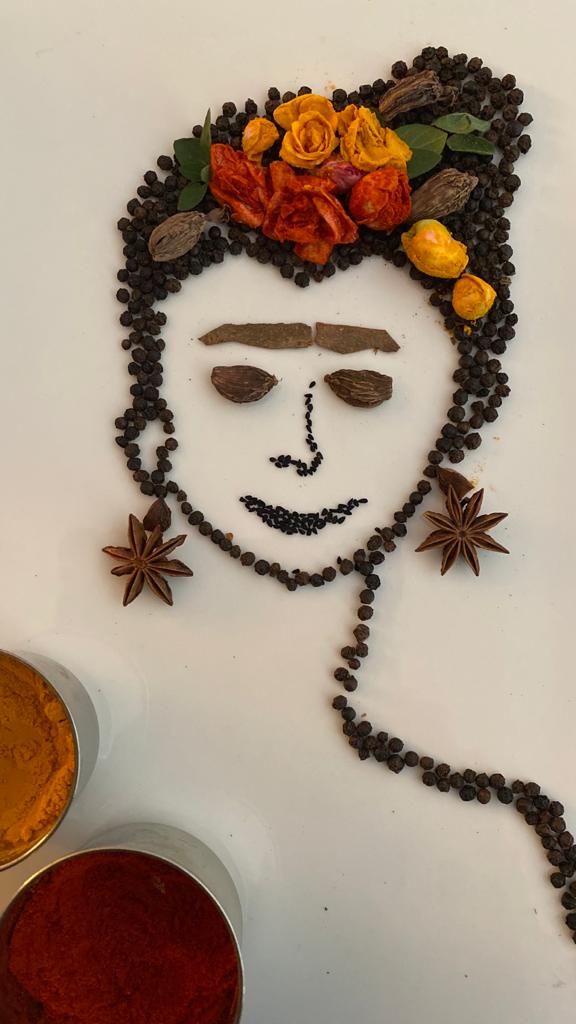Warming Spices for Winter
By Conchita de Souza

Cover Image: Spiced Frida Art by Claudette D'Cruz
If I have to love anything about winter (believe me as a child of the heat I have to search hard for things to love), it would be the insatiable desire to eat my way to a state of warmth and comfort. Oh, and woolly cardigans as well as sleeping snuggled under blankets. Whilst summer meals can be quick, light, fresh and breezy much like the season itself, eating during winter is almost a sacred ritual from the act of preparing to dishing out.
From an evolutionary perspective and in the natural world, winter is a time of dormancy or hibernation; storing whatever energy we can from the reduced hours of daylight, trying to keep ourselves warm against the harsh cold and staying put. From a culinary perspective, the cold season is a great time for hearty stews, steaming soups, slow-cooked curries, anything-with-a-side-of-potatoes and mulled wines. You will notice that your body craves different foods during the colder months and for many, carbohydrates can be the ultimate comfort but you can rely on other sources as well.
Thermogenesis - Production of Heat
At a very basic level, the food we consume is used by our bodies as fuel for energy and nutrients. “Thermogenesis is essentially the energy “cost” it takes to break down your food, digest it, and turn it into fuel”.* Certain foods take longer to digest, burn more calories and therefore raise our body temperature and make us feel warmer, which is exactly what we need during these times when inflation is causing pain to our pockets.**
In Indian cuisine, it is the use of spices that brings warmth to a particular dish and produces that thermogenic effect. Some of the spices below are commonly used in western baking to achieve a similar purpose.
Warming Spices
Cardamom (Green) - India is a large producer of this fragrant spice which happens to be the second most expensive spice in the world, after saffron. However, not a lot is exported due to domestic demand. The largest exporter of cardamom is Guatemala. Cardamom has a sweet, beautiful aromatic perfume and is used in India to flavour both sweet and savoury dishes. It is used by the Finns in a bread called pulla; In the Middle East it used to flavour sweet dishes, tea and coffee. In South East Asia it is used to treat infections in teeth and gums. It is also used to break up kidney and gall stones. It is heavily relied upon in traditional medicines – Ayurveda and Chinese medicine. Here is a fun fact for you, 7 pods = 1 teaspoon of ground cardamom.

Cardamom (Black) - This variation has a strong and smoky flavour and aids with digestion, which in turn, warms up the body. Unlike its green sibling, black cardamom is used as a whole due to its dominating flavour so the seeds remain cocooned in the pod so as not to release too much of its intensity.
Cinnamon - Cassia is used to flavour baked goods, candies and meat. In India it is used in many curry recipes and is also used to flavour Pilafs and Biryanis with an aromatic essence. A warming way to start a cold winter’s day is with a dash of cinnamon on top of your morning porridge, banana smoothie or toast slathered with nut butter. 
Cloves - A very aromatic spice perfuming everything with which it comes into contact and is antibacterial and antifungal and in nature. Many Ayurvedic toothpastes use clove as an ingredient and I remember my mum telling me to suck on a clove to freshen my breath rather than mint or gum.

Coriander - The coriander plant possesses both healing and cooling properties, depending on what part of the plant is being used. The leaves are considered to be cooling however the seeds have a warm, nutty and citrus-like aroma and assist with digestion. When my tummy feels out of sorts, I make a quick concoction of Cumin, Coriander and Fennel tea by boiling equal amounts of each spice for 10-15 minutes before drinking it hot.

Cumin - Cumin is the second most popular spice in the world after black pepper. It is a member of the parsley family and resembles caraway in appearance but not in taste. It is commonly used in Brazilian, Cuban, Indian, North African, Mediterranean, Middle Eastern, Mexican Pakistani, Sri Lankan, and Western Chinese cuisines. It is also used in Dutch cheeses and in some traditional French bread. It was heavily used in ancient Roman cuisine. Cumin is said to help in the treatment of the common cold when added to hot milk and consumed. In Sri Lanka the seeds are toasted then boiled. The resultant tea is used to soothe stomach problems.

Ginger - We prepare our chai at home with a healthy amount of fresh ginger that is boiled with the water before adding the tea leaves. Ginger is a very warming spice and one particular study from Japan has shown that its intake increased body surface temperature.***
Garam Masala Garam in Hindi means heat or hot – this blend is a mixture of whole spices that are roasted to bring out their aromas and can be used as a whole or ground. It is commonly used in Bangladeshi, Indian and Pakistani cuisine.
To make your own Garam Masala, roast the following spices on a pan, one spice at a time till aromatic:
- Green Cardamom (30g)
- Cloves (10g)
- Cinnamon (8g)
- Mace (2g)
- Nutmeg (4g)
- Pepper (10g)
- Star Anise (1 whole)
Store in the freezer. Use 1 dessertspoon per kg of meat or lentil dishes. You can use this masala, albeit sparingly, in vegetable dishes such as Palak Paneer.
Peppercorn - Salt and pepper are the basic of all condiments and the latter was once revered as black gold for its flavour-enhancing and preserving functions. The plant is native to the south of India and gets its punch from the compound piperine. You can add a pinch of ground pepper to your hot drink or sweet desserts for an extra kick and with desserts, for a more pronounced flavour (think chocolate truffles).

When winter is upon us and we know where to look, we can trust Mother Nature to keep us warm, safe and nourished all at once!
* Hinchman, W [21 August 2021] Thermogenic Foods That Can Boost Your Metabolism https://swolverine.com/en-au/blogs/blog/thermogenic-foods
** Pasi, Dr M [28 January 2021] 10 Foods to Keep You Warm https://poshan.outlookindia.com/story/poshan-news-10-food-tips-to-enjoy-winters-like-a-pro/372484
*** Fujisawa, F. (Shiga Prefectural Univ., Hikone (Japan)); Nadamoto, T.; Fushiki, T.; (2005) Hyperthermic Effect of Ginger (Zingiber officinale) Extract-Containing Beverage on Peripheral Skin Surface Temperature in Women. Journal of Japanese Society of Nutrition and Food Science (Japan)

0 comments